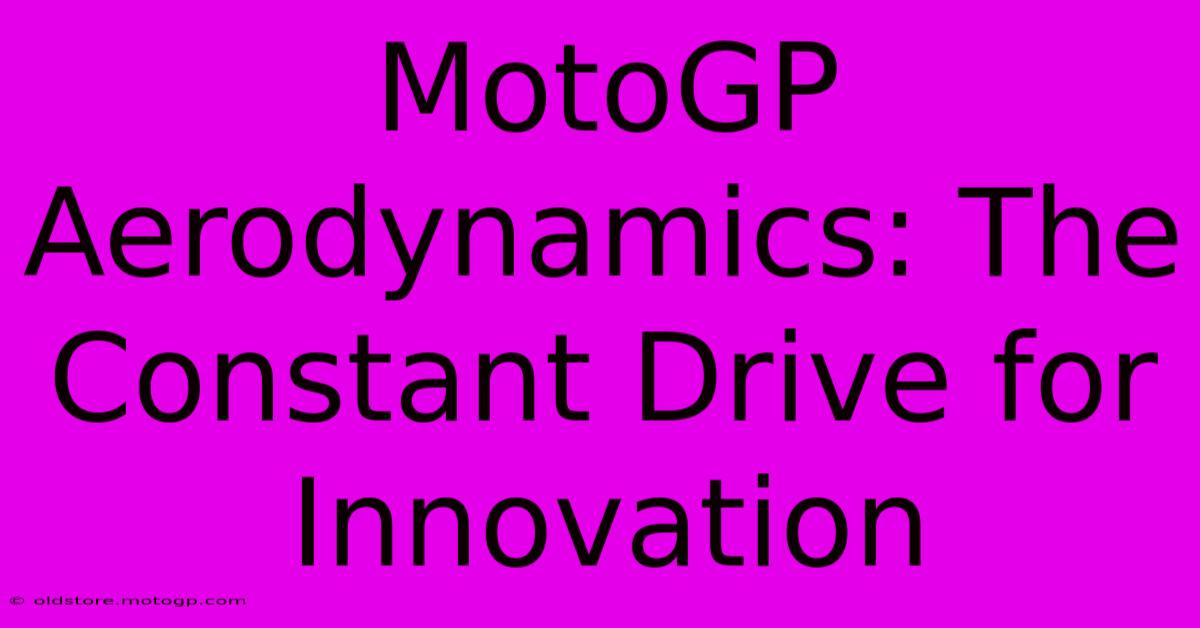MotoGP Aerodynamics: The Constant Drive For Innovation

Table of Contents
MotoGP Aerodynamics: The Constant Drive for Innovation
MotoGP, the pinnacle of motorcycle racing, is a relentless pursuit of speed and performance. Every marginal gain counts, and in recent years, aerodynamics has emerged as a crucial battleground for technological supremacy. This article delves into the fascinating world of MotoGP aerodynamics, exploring the constant drive for innovation and the impact it has on the sport.
The Science of Speed: Understanding MotoGP Aerodynamics
MotoGP bikes are not simply fast; they're aerodynamic marvels. At speeds exceeding 200 mph, even small aerodynamic improvements can translate into significant lap time reductions. The science behind this involves manipulating airflow around the motorcycle to reduce drag and increase downforce.
Reducing Drag: The Silent Speed Boost
Drag is the resistance a bike encounters as it moves through the air. Minimizing drag is paramount. Teams achieve this through meticulous design of fairings, using computational fluid dynamics (CFD) simulations to optimize the shape and airflow around the bike. Every curve, every edge, is carefully considered to streamline the motorcycle and reduce its aerodynamic footprint. This includes:
- Streamlined Fairings: Sophisticated fairings are designed to minimize turbulence and separate airflow smoothly.
- Aerodynamic Winglets: These small wings help to manage airflow and reduce drag in specific areas.
- Improved Rider Positioning: Even the rider's position plays a role in minimizing drag.
Generating Downforce: The Grip Advantage
While reducing drag is essential, generating downforce is equally important. Downforce, the force pushing the bike towards the track, improves stability at high speeds and enhances cornering grip. Key components contributing to downforce include:
- Wings and Airfoils: These generate downforce by manipulating airflow, effectively "sucking" the bike towards the track. The design and placement of these wings are constantly evolving.
- Underbody Aerodynamics: The design of the underbody is critical for managing airflow and creating a ground effect, further increasing downforce.
- Fairing Design: The fairing itself contributes to downforce, with its shape influencing how air flows over and under the bike.
The Evolution of MotoGP Aerodynamics: A Technological Arms Race
The development of MotoGP aerodynamics is a continuous process, driven by the constant search for performance gains. We've seen a dramatic evolution over the years:
- Early Days: Relatively simple fairings with minimal aerodynamic enhancements.
- The Rise of Winglets: The introduction of winglets revolutionized MotoGP aerodynamics, significantly improving stability and cornering speed.
- Sophisticated Wing Designs: Current designs are far more complex, incorporating multiple winglets and aerodynamic surfaces to fine-tune airflow management.
- CFD Simulations: The use of advanced computational fluid dynamics (CFD) simulations allows teams to test and refine designs virtually before physical testing, significantly accelerating the development process.
The Future of MotoGP Aerodynamics: What Lies Ahead?
The future of MotoGP aerodynamics promises even more innovation. We can expect to see:
- Further Refinement of Existing Technologies: Expect even more sophisticated wing designs and aerodynamic surfaces.
- New Materials and Manufacturing Techniques: The use of lighter and stronger materials will be key in optimizing performance.
- Increased Integration of Rider Feedback: Closer collaboration between riders and engineers will lead to more effective aerodynamic solutions.
- Active Aerodynamics: This exciting area involves the use of adjustable aerodynamic components to optimize performance in different track conditions and racing situations.
Conclusion: A Never-Ending Pursuit of Performance
MotoGP aerodynamics is a constantly evolving field, pushing the boundaries of engineering and innovation. The relentless pursuit of marginal gains through aerodynamic optimization continues to shape the sport, delivering breathtaking speeds and thrilling races. The innovations seen in MotoGP eventually trickle down to commercially available motorcycles, benefiting riders of all levels. The quest for speed continues, and aerodynamics will undoubtedly play a central role in the future of this exhilarating sport.

Thank you for visiting our website wich cover about MotoGP Aerodynamics: The Constant Drive For Innovation. We hope the information provided has been useful to you. Feel free to contact us if you have any questions or need further assistance. See you next time and dont miss to bookmark.
Featured Posts
-
How To Choose The Right Size Moto Gp Helmet
Feb 25, 2025
-
The Essential Cota F1 Merchandise Checklist
Feb 25, 2025
-
Moto Gps Near Misses Avoiding Disaster
Feb 25, 2025
-
Houstons F1 Thrill Ride Buckle Up
Feb 25, 2025
-
Moto Gp Aerodynamics And The Future Of Motorcycle Racing
Feb 25, 2025
